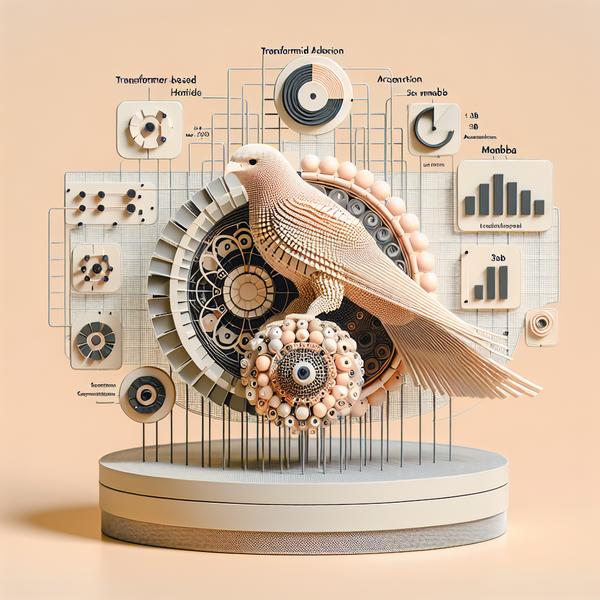
The Falcon-H1 series by the Technology Innovation Institute (TII) represents a groundbreaking leap in large language model (LLM) development. This innovative model brings together Transformer-based attention and Mamba-based State Space Models (SSMs) in a novel hybrid architecture to redefine how models balance computational limits and output quality. Falcon-H1 offers a variety of sizes, ranging from 0.5B to 34B parameters, and includes features like instruction tuning and quantization. Its extensive tokenization and multilingual capabilities make it an unparalleled choice that rivals models like Qwen2.5-72B and LLaMA3.3-70B, setting new standards for efficiency and scalability in AI.
Unpacking Falcon-H1’s Hybrid Architecture
- Falcon-H1 stands out by combining attention mechanisms with State Space Models (SSMs) in a parallel hybrid configuration. Imagine baking two layers of a cake simultaneously and perfectly blending their flavors — that's how this setup works to boost efficiency.
- Instead of layering the components one after the other like most traditional architectures, Falcon-H1 runs attention heads and SSM modules in tandem. Their outputs merge seamlessly into a final cohesive result, maximizing memory use and computational efficiency.
- The flexible channel-to-channel ratio (2:1:5 for SSM, attention, and MLP) allows customization for different use cases. For example, think of a smartphone that adjusts screen brightness depending on the lighting — Falcon-H1 also adapts to balance resource usage dynamically.
- This configuration wasn’t an accident; detailed tests (called ablation studies) found that careful balancing is crucial. Too much attention, just like too much spice in food, can ruin the whole “recipe.”
Tokenization: The Foundation of Learning Multilingual Brilliance
- Falcon-H1 employs a unique tokenizer with a vocabulary of up to 261K entries, making it multilingual-ready. It’s like giving someone a dictionary that not only has a variety of languages but also includes math symbols — perfect for solving equations and multilingual tasks.
- Special care goes into splitting digits and punctuation, which fine-tunes the model’s accuracy, especially in handling complex programming codes or multiple languages.
- A unique feature is the injection of LaTeX mathematical tokens. This is akin to upgrading a student’s education with an advanced calculator — suddenly, solving math problems becomes second nature for the model.
- Languages supported by Falcon-H1 span eighteen core options, with potential for over a hundred more as the tech scales. This wide range allows users worldwide to utilize its features in their native tongue.
Tailored Training and Data Strategy
- Training Falcon-H1 is like preparing for a marathon: it demanded a curated dataset of a staggering 20 trillion tokens. From Wikipedia articles to high-quality web data, these varied sources enriched its learning experience.
- Incorporating math datasets like GSM8K and MATH was another strategic move. Think of these as practice sessions with the hardest possible questions, sharpening the model's ability to tackle challenges like never before.
- Interestingly, the model also used synthetic data — which is like playing chess against itself to improve strategically, rewriting corpora and generating textbook-like Q&A sets.
- Long-text processing tasks up to an eye-popping 256K tokens mean Falcon-H1 can handle everything from novels to complex legal documents seamlessly.
Performance and Practical Applications
- Performance-wise, Falcon-H1-34B-Instruct rivals the giants in the industry, surpassing models like Qwen2.5-72B in reasoning and multilingual understanding tasks. Imagine a race car outpacing a supercar on a tough track — that's what this model achieves in AI benchmarks.
- The smaller variants, like Falcon-H1-1.5B-Deep and Falcon-H1-0.5B, are no slouches either. Designed to provide robust performance with fewer parameters, they rival older 7B models in capability.
- On reasoning and multilingual benchmarks like MMLU and HumanEval, the model achieved groundbreaking results. Whether solving puzzles or translating texts, Falcon-H1 consistently delivers the right answers faster.
- Direct Preference Optimization (DPO) ensures better alignment with user intent — much like an assistant understanding your preferences without needing constant reminders.
Impactful Insights for Future Deployments
- Falcon-H1 marks a pivotal point in making AI scalable, adaptable, and deployable across edge devices. Quantized versions using bfloat16 and 4-bit support lower the entry barrier for more tech enthusiasts.
- Its Mixer Parallelism and Context Parallelism enable exceptional throughput. Think of it as turbocharging your car engine to handle both the city traffic and open highways without missing a beat.
- This flexibility means Falcon-H1 models can extend beyond research labs, fitting into educational tools, healthcare support systems, and more.
- Imagine using this model in a wearable device or a lightweight home assistant — its compact builds and efficient computations make such futuristic applications accessible today.
Conclusion
Falcon-H1 redefines the boundaries of what’s possible with large language models. By combining a ground-breaking hybrid architecture, refined tokenization, and diverse training methodologies, the Falcon-H1 family establishes itself as a versatile, efficient player in the AI world. Whether for researchers, developers, or businesses, these models deliver unmatched performance, enabling the industry to scale new heights while making advanced language processing accessible to all.